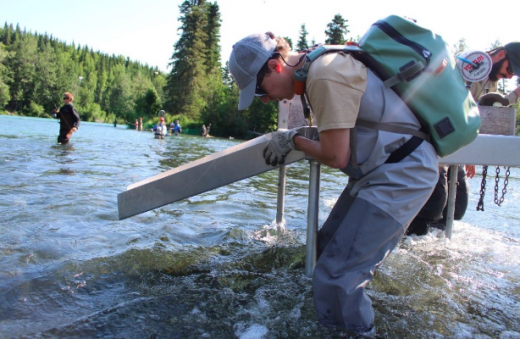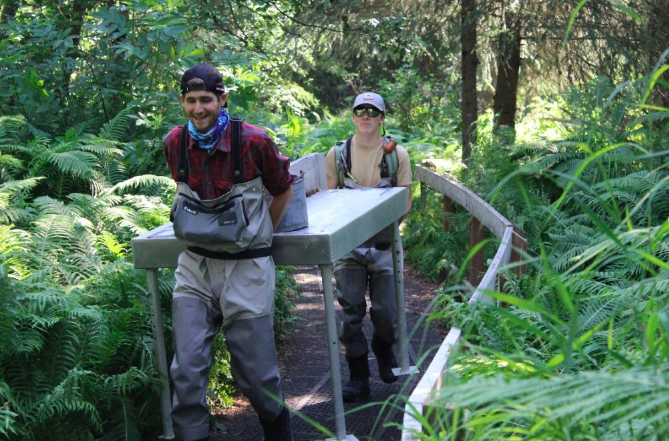Editor’s note: Building off the success of last year’s Native Odyssey campaign, Trout Unlimited is sending four of our brightest college club leaders in the TU Costa 5 Rivers Program to explore the home of the world’s largest runs of wild salmon: Alaska. Starting July 5, these students will explore the Kenai Peninsula, Bristol Bay and the Tongass National Forest in pursuit of the five species of Pacific salmon and other native Salmonids that call Alaska home. In partnership with Costa Sunglasses, Simms Fishing Products, the U.S. Forest Service, Fishpond USA, and Orvis, these students will seek to unearth, document, and share the challenges facing the largest salmon fisheries in the world.
I drug myself out of my tent into the damp Alaskan morning and shoveled a few spoonful’s of oatmeal into my mouth before throwing on my waders. We groggily left camp and met up with Tyler Gagat, coordinator of the Kenai Peninsula Stream Watch, for a crash course in river safety. Tyler works for the U.S. Forest Service and leads volunteers in Stream Watch’s efforts to monitor, maintain and protect the Russian River.
We knew we would be in for a long day of hard work when we were given our first task: carry a cleaning table down the mile-long trail to the confluence of the Russian and Kenai rivers. Thanks to Stream Watch, there is a light-penetrating boardwalk that allows anglers to walk along the river without damaging the plants along the bank.
The cleaning tables are strategically placed by the Forest Service in the confluence of the Kenai and Russian rivers, to encourage anglers to throw their fish scraps in the swift current of the Kenai and away from curious bears. This keeps anglers, bears and campers safe and ensures that bears do not come to rely on fish waste as an easy meal.
After securing the cleaning table in the swift current, we picked up our rebar pounders and zip ties and began repairing fencing that had been knocked down by either bears or humans. The fences prevent people from walking along fragile areas of the banks and damaging the plants that hold the bank together. In some areas, we put up half-fence so that bears can still make their way to the river to munch on salmon.
 While we were working, Tyler explained the impact that healthy river banks can have on fish and other aquatic organisms. When anglers and hikers tread over the plants along the bank, they are damaging the root systems that hold the bank in place and prevent erosion. To combat this, Stream Watch volunteers put up fencing every year to prevent people from accessing certain parts of the bank.
While we were working, Tyler explained the impact that healthy river banks can have on fish and other aquatic organisms. When anglers and hikers tread over the plants along the bank, they are damaging the root systems that hold the bank in place and prevent erosion. To combat this, Stream Watch volunteers put up fencing every year to prevent people from accessing certain parts of the bank.
Tyler pointed out some areas of the bank that have been allowed to recover and flourish over several years are now creating pristine habitat for fish and wildlife. On several occasions during our work with Stream Watch, Tyler alluded to a time when the Russian River was wider, muddier and had fewer fish. This unhealthy habitat was caused by erosion, flooding, and poor management, and it resulted in warmer waters that were harder on spawning salmon.
It was refreshing to see how people respected the efforts of Stream Watch and the U.S. Forest Service. One angler stopped to tell us about the improvements he has seen from fishing the Russian for the past few decades. Working with Tyler Gagat for a few days gave me a new perspective on why anglers should become involved in conservation efforts. Programs like Stream Watch give anglers and outdoor enthusiasts a way to connect with aquatic ecosystems and work toward sustaining these unique salmon fisheries.



